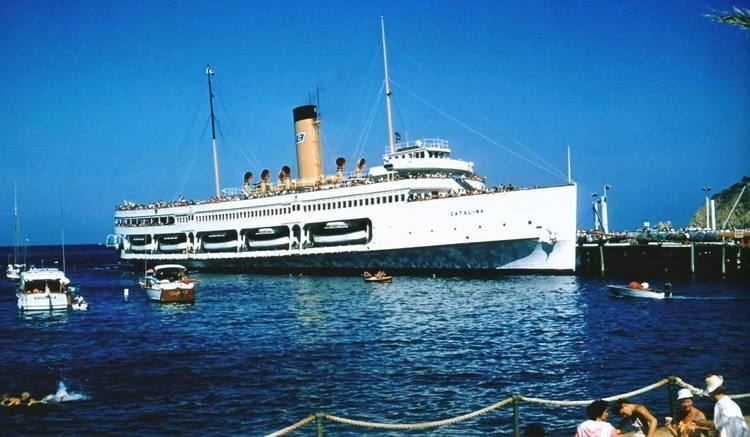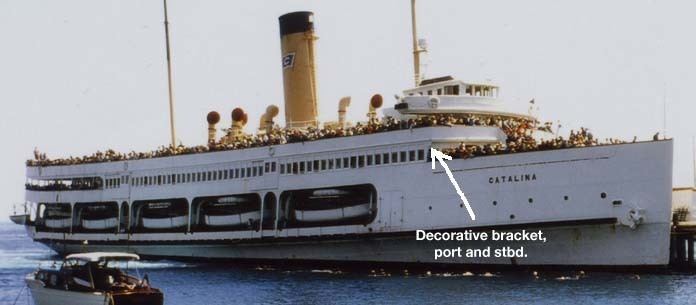Laid down December 26, 1923 Construction started 26 December 1923 Opened 1924 | Christened May 3, 1924 Launched 3 May 1924 Added to NRHP 1 September 1976 | |
 | ||
Name Catalina (1924–42)FS 99 (1942–46)Catalina (1946–2009) Owner Wilmington Transportation Company (1924–42)M.G.R.S. (1960–75) (M-Vern Maynard, G-June Gates, R-Fred Rosenberg, S-Charlie Stillwell)Hymie & Ruth Singer (1977–96) Operator Catalina Island Steamship Line (1924–42)US Army (1942–46)Catalina Island Steamship Line (1946–75) Builder Los Angeles Shipbuilding and Drydock Company Similar Ralph J Scott, Catalina Casino, Bird Park, Museo del Puerto, Catalina Island Museum | ||
Retro 1950s cruise ss catalina sails again to avalon
SS Catalina, also known as The Great White Steamer, was a 301-foot steamship built in 1924 that provided passenger service on the 26-mile passage between Los Angeles and Santa Catalina Island from 1924 to 1975. According to the Steamship Historical Society of America, Catalina has carried more passengers than any other vessel anywhere. From August 25, 1942 until April 22, 1946 the ship served as the Army troop ferry U.S. Army FS-99 at the San Francisco Port of Embarkation transporting more than 800,000 troops and other military personnel between embarkation camps and the departure piers. After a period of service as a floating discothèque, the ship ran aground on a sandbar in Ensenada Harbor in 1997 and remained there half-submerged and decaying for more than a decade.
Contents
- Retro 1950s cruise ss catalina sails again to avalon
- Ss catalina in ensenada mexico
- Design and construction
- Passenger service to Santa Catalina Island
- World War II troop ferry
- Retirement and abandonment in Ensenada
- Historic recognition and preservation efforts
- Demise
- Videos
- References

In January 2009 it was announced that the ship would be cut up for scrap, which has been completed.

Ss catalina in ensenada mexico
Design and construction

Catalina was constructed by the Los Angeles Shipbuilding and Drydock Company for the Wilmington Transportation Company which had long served Catalina Island and was purchased with the island by William Wrigley Jr., the chewing gum and confectionery magnate. The ship was to join the steamers Avalon, Cabrillo and Hermosa already serving the island and designed to make the trip from Los Angeles Harbor to Avalon of 25.5 nautical miles (29.3 mi; 47.2 km) in one and a half hours.

Catalina was designed as a twin-screw steel steamer for daylight operation with a glass-enclosed, except for open areas forward and aft, saloon deck with a ballroom with a promenade deck exclusively for passengers. There were ten staterooms on the main deck and four staterooms plus an owners suite on the promenade deck. The ship was 301 feet 7.5 inches (91.9 m) in length overall, 285 feet (86.9 m) length between perpendiculars, 52 feet (15.8 m) beam moulded at the main deck, 44 feet (13.4 m) beam at the waterline with a mean draft of 13 feet 5 inches (4.1 m) at load displacement of 2,390 tons. The hull was double bottomed with tanks for fuel and water ballast with six transverse watertight bulkheads extending to the main deck. A unique feature of the ship was the arrangement of the lifeboats which were stowed on the main deck in order to provide best arrangement for the passenger decks above and quick and efficient launching. Propulsion was by two triple expansion steam engines with cylinders of 20.5 inches (0.52 m), 35 inches (0.89 m) and 60 inches (1.52 m) with stroke of 36 inches (0.91 m) fed by four forced draft boilers and designed for 3,600 i.h.p. at 100 revolutions. Two 40 kilowatt generators provided electrical power.
Keel laying for Catalina was on December 26, 1923, with launching on May 3, 1924 with company and Los Angeles city officials present and delivery on July 1, 1924.
The ship was reportedly built in at a cost of $1 million.
Passenger service to Santa Catalina Island
Between 1924 and 1975, Catalina carried about 25 million passengers between Los Angeles and Avalon Harbor. According to the Steamship Historical Society of America, Catalina has carried more passengers than any other vessel anywhere.
In its heyday, the ship was known as the "Great White Steamer" and carried 2,000 passengers at a time on the two-and-a-half hour trip to Catalina. Among its famous passengers were Presidents Calvin Coolidge and Herbert Hoover, actor Robert Mitchum and many of the great musicians of the Big Band era. The Los Angeles Times recalled the passage this way:
"To board the Catalina during its heyday was to enter a world of luxurious leather settees and gleaming teak. On the upper deck people danced to swinging big bands. Magicians and clowns entertained passengers. On the lower deck youngsters played hide and seek among the lifeboats, and couples found hidden spots where they could be alone. ... Residents fondly remember the rituals with which the ship was greeted as it approached the island: Speedboats would circle the ship, water skiers slicing through its giant wake. Closer to shore, children swam out to dive for coins passengers tossed into the bay. People in Avalon gathered to sing as passengers stepped off the ship that docked near the center of town."
In 1958, the 26-mile trip to Catalina Island was made famous by Four Preps' hit song "26 Miles (Santa Catalina)". The song reached the #2 position on the U.S. popular music charts. The metric distance of "40 kil-o-meters" also is sung.
In 1960, fed up with all of the excessive taxation and union pressure, Phillip K. Wrigley sold the ship to a group of investors, known as M.G.R.S. President, Charlie Stillwell, and Vice President, Vern Maynard who was also President of Channel Concessions, ran the ship, as well as managed the Casino Ballroom during the early to mid-1960s.
The ship is featured in the 1967 film "Catalina Caper".
World War II troop ferry
On August 25, 1942 Catalina was delivered to the War Shipping Administration (WSA) and placed under bareboat basis to the War Department on the same date. The ferry was designated a Coastal Freighter and Passenger Vessel (FS) and assigned the Army number FS-99. US Army FS-99 was used to transport troops from embarkation camps to the ocean transports throughout the San Francisco Port of Embarkation. The ship's troop capacity was 2,500 with a civilian crew of 39 officers and men.
As the Army began equipping its large ocean transports with new radar in 1946 an obsolete set was installed aboard FS-99 and adjusted to detect nearby objects for tests in use under harbor conditions. Tests were successful with the ship's master, Howard J. King, stating he "wouldn't be without it." A newer Raytheon model S0-8 radar set was installed, making the ship the first Army harbor vessel so equipped, and on its first use in a regular trip bringing returning troops to Camp Stoneman located the Army ferry Hayward grounded in a fog.
The ship's last week, before being declared surplus to the port and Army's needs, was her busiest with 12,764 Army personnel transported. The ship had been the last contact troops had with continental transportation before boarding ocean transports and shipping overseas and was now the first for those returning from the Pacific. On her last run, during which she was turned over to WSA with her Army service master, former Sacramento river pilot Captain Howard J. King, turning her over to her peacetime master, Captain E. L. Mussetter. The ship was returned to civilian service on April 22, 1946.
FS-99 transported more military personnel than any other military transport with a total of about 820,000 troops transported within the San Francisco Bay area.
Retirement and abandonment in Ensenada
By the early 1970s, smaller, faster vessels made it difficult for Catalina to compete for passenger traffic, and she was retired from passenger service in 1975.
In 1977 Catalina was bought at auction for $70,000 by real estate developer Hymie Singer. He bought the ship as a Valentine's Day gift for his wife and the steamship was moved for several years between Newport Beach, San Diego, Santa Monica Bay and Long Beach. At one point, there was a proposal for Catalina to ferry tourists up the Nile River, but her 21 feet of draft was too deep for the river. As the ship bounced from one port to another, one writer noted: "Twice she broke free of her moorings in Long Beach and once nearly hit a tanker; it was as if the ship was rebelling against her fate, having gone from being a source of pride to an embarrassment to a naval hazard."
In 1985 Singer moved the ship to Ensenada, Baja California, where she became the focus of a series of unsuccessful business ventures, including a floating discothèque and the Catalina Bar and Grill. In late 1997 Catalina escaped her moorings and grounded on a sandbar in Ensenada Harbor. Since then, Catalina remained half-submerged and stuck in the mud in the harbor. After years of neglect, Catalina was badly decayed and rusted and had been stripped by looters and vandals.
Historic recognition and preservation efforts
Catalina was recognized as a Los Angeles Historic-Cultural Monument (LAHCM #213) by the city's Cultural Heritage Commission, and was a California Historical Landmark. She was listed on the National Register of Historic Places in 1976. Preservationists had sought since the late 1990s to raise funds to return Catalina to Los Angeles for restoration. Others had opposed raising the ship, saying, "It's like digging up grandma and putting her at the head of the table."
Demise
Catalina was finally broken up after sitting in Ensenada Harbor for about 12 years. The scrapping of Catalina began in January 2009 and was finished by late 2009 or early 2010.
